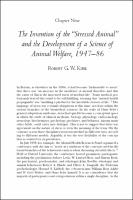Chapter 9 The Invention of the 'Stressed Animal' and the Development of a Science of Animal Welfare, 1947-86
Author(s)
Kirk., Robert G.W.
Jackson, Mark
Ramsden, Edmund
Cantor, David
Collection
WellcomeLanguage
EnglishAbstract
Stress is one of the most widely utilized medical concepts in modern society. Originally used to describe physiological responses to trauma, it is now applied in a variety of other fields and contexts, such as in the construction and expression of personal identity, social relations, building and engineering, and the various complexities of the competitive capitalist economy. In addition, scientists and medical experts use the concept to explore the relationship between an ever increasing number of environmental stressors and the evolution of an expanding range of mental and chronic organic diseases, such as hypertension, gastric ulcers, arthritis, allergies, and cancer. This edited volume brings together leading scholars to explore the emergence and development of the stress concept and its definitions as they have changed over time. It examines how stress and closely related concepts have been used to connect disciplines such as architecture, ecology, physiology, psychiatry, psychology, public health, urban planning, and a range of social sciences; its application in different settings such as the battlefield, workplace, clinic, hospital, and home; and the advancement of techniques of stress management in a number of different national, sociocultural, and scientific locations.
Keywords
history of science & medicine; history of science & medicine; Animal testing; Animal welfare; Ethology; Hans Selye; Physiology; Psychosomatic medicine; Quality of life; Universities Federation for Animal WelfareDOI
10.26530/oapen_478052OCN
1051782034Publisher
University of Rochester PressPublication date and place
Rochester, 2014Series
Rochester Studies in Medical History,Classification
History of medicine


 Download
Download Web Shop
Web Shop